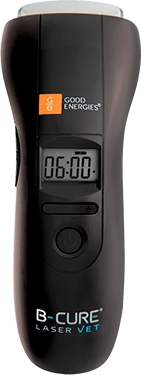Understanding Pododermatitis in Pets: Causes, Symptoms, and Treatment Options
Pododermatitis, a common condition affecting the paws of pets, can be a source of discomfort and pain for our furry companions. It refers to inflammation of the skin on the feet and can occur in dogs, cats, and other animals that rely heavily on their paws for mobility. In this blog, we will delve into the various aspects of pododermatitis, including its causes, symptoms, and treatment options, with a special focus on the role of laser therapy devices like BCure in managing this condition effectively.
What is Pododermatitis?
Pododermatitis, also known as “interdigital dermatitis,” is a dermatological condition that affects the skin and tissues between the toes of pets. While it is a common issue in animals, it can manifest in different forms and severities, making it important for pet owners to be vigilant and seek veterinary care promptly when signs appear.
Causes of Pododermatitis
Several factors can contribute to the development of pododermatitis in pets. Some of the primary causes include:
- Allergies: Allergens, such as pollen, dust mites, certain foods, or chemicals, can trigger an allergic reaction in sensitive pets, leading to pododermatitis.
- Parasites: External parasites like fleas, ticks, and mites can infest the paws, causing irritation and inflammation.
- Infections: Bacterial or fungal infections can thrive in the warm and moist environment between the toes, leading to pododermatitis.
- Foreign Objects: Splinters, thorns, and other foreign objects lodged in the paw pads can cause irritation and infection.
- Autoimmune Disorders: In some cases, the pet’s immune system may mistakenly attack its own paw tissues, leading to pododermatitis.
- Obesity: Excessive weight can put added pressure on the paws, leading to inflammation and discomfort.
Symptoms of Pododermatitis
The symptoms of pododermatitis can vary depending on the underlying cause and the severity of the condition. Pet owners should look out for the following signs:
- Redness and Swelling: Inflamed paw pads may appear red, swollen, and tender to the touch.
- Limping or Lameness: Pets may exhibit limping or reluctance to bear weight on the affected paw.
- Paw Chewing and Licking: Pets may excessively chew or lick their paws in response to the discomfort.
- Crusty or Scaly Skin: The skin between the toes may become dry, crusty, or scaly.
- Pus or Discharge: In cases of infection, there may be pus or other discharges from the affected area.
- Unpleasant Odor: An unpleasant smell from the paws could indicate infection.
Treatment Options for Pododermatitis
The treatment of pododermatitis depends on the underlying cause and the severity of the condition. Some common treatment options include:
- Topical Medications: Veterinarians may prescribe medicated creams or ointments to reduce inflammation and manage infections.
- Antibiotics or Antifungals: In cases of bacterial or fungal infections, oral antibiotics or antifungal medications may be necessary.
- Paw Soaks: Soaking the affected paws in a mild antiseptic solution can help clean and soothe the area.
- Weight Management: For overweight pets, weight management is crucial to relieve pressure on the paws and reduce inflammation.
- Allergy Management: Identifying and managing allergens can help prevent recurrent episodes of pododermatitis in allergic pets.
- Laser Therapy with BCure: Laser therapy devices like BCure have shown great promise in the treatment of pododermatitis. These devices utilize low-level laser therapy (LLLT) to promote healing, reduce inflammation, and alleviate pain. LLLT works by stimulating cellular activity and increasing blood flow to the affected area, which aids in the natural healing process.
Laser Therapy with BCure for Pododermatitis Treatment
BCure is a cutting-edge laser therapy device that has been specifically designed for veterinary use. Its non-invasive and painless treatment makes it ideal for managing pododermatitis in pets. The device emits low-level laser energy directly to the inflamed paw pads, stimulating cell regeneration and accelerating the healing process.
The benefits of using BCure for pododermatitis treatment include:
- Pain Relief: Laser therapy with BCure provides pain relief for pets suffering from the discomfort of pododermatitis.
- Anti-Inflammatory Effect: The treatment reduces inflammation, swelling, and redness in the affected area.
- Enhanced Healing: BCure’s LLLT stimulates the production of collagen and promotes faster healing of damaged tissues.
- Non-Invasive and Safe: BCure’s laser therapy is non-invasive, painless, and does not require sedation, making it stress-free for pets.
- Easy to Administer: Veterinarians can easily administer BCure’s laser therapy during routine visits, and pet owners can also use it at home under professional guidance.
- No Side Effects: BCure’s laser therapy has no known adverse side effects, making it a safe option for long-term use.
How BCure Laser Therapy Works?
BCure laser therapy devices emit a specific wavelength of light that penetrates deep into the tissues, stimulating cellular activity and increasing blood flow. The increased blood flow brings oxygen and nutrients to the affected area while removing waste products, which aids in the healing process. Additionally, the laser therapy helps activate the body’s natural anti-inflammatory mechanisms, reducing swelling and pain.
Administering BCure Laser Therapy
BCure laser therapy devices are user-friendly and can be easily operated by both veterinarians and pet owners. The device is moved gently over the affected paw pads for a few minutes during each session. The frequency and duration of treatment depend on the severity of the pododermatitis and the pet’s response to therapy.
Conclusion
Pododermatitis can significantly impact a pet’s quality of life, but with early detection and proper treatment, it can be effectively managed. Laser therapy devices like BCure offer a safe, non-invasive, and drug-free option to reduce inflammation, alleviate pain, and accelerate healing.
If you suspect that your pet is suffering from pododermatitis, it is essential to seek professional veterinary advice promptly. A veterinarian can diagnose the underlying cause and recommend appropriate treatment, which may include laser therapy with BCure to enhance the healing process and bring comfort to your beloved companion. Always consult your veterinarian before starting any treatment, including laser therapy, to ensure the best possible care for your pet’s specific needs.
Remember, a healthy and pain-free paw is a happy paw!




